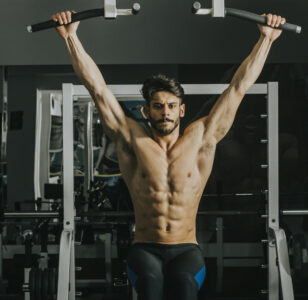Dip Station is a very high-quality fitness product that helps the body build muscle and muscle tone. The pull-up dip station is a great choice if you want to try a home workout. Dip stations are good for the body in many ways, like making the upper limbs, shoulder girdle, chest, abdomen, and back muscles stronger and more flexible. They also make the upper-limb joints more stable and improve coordination and balance. It can also help fix problems with the way the shoulder, elbow, and wrist joints work. This article can help you with what you want to know about the best power towers and Dip Station training moves to help you train your abs, arms, and leg muscles. In addition, if you have a power tower, you can also do the same training on it, the power tower can also achieve good training results
How to complete the pull-up bar ab workout?

Support hold:The support hold is a basic Dip Station workout that works the triceps, biceps, forearms, shoulders, chest, and core.
The basis of this training movement is that you need to have enough arm strength to support your body. First, you need to hold the dip station with both hands, support your body, and, facing backward, straighten your arms.
Cross your legs and bend back slightly. Keep your abdominal muscles tight and look straight ahead.
Hold the position still for 30 seconds.
Dip: Hold the dip station with both hands and support your entire body upwards; at this point, your body hangs in the air.
Bend your knees and cross your calves, tighten your abdominals, and slowly bend your elbows down.
Stop when your upper arms are parallel to the floor, and repeat by lifting your body back upwards.
It strengthens the triceps, the front of the shoulders, and the lower pectoral muscles. It also works the upper back muscles by accident.
During the training, keep your body in a slightly forward leaning position, and do not lower your shoulders below your elbows when flexing and lowering your elbows to avoid shoulder injuries.

Dip negative: Hold the dip station with both hands and support your entire body upwards; at this point, your body hangs in the air.
Bend your knees and cross your calves backward; tighten your abdominals; and slowly bend your elbows down.
Unless your feet touch the ground, then land slowly.
Note: Dip negative is a tough exercise that builds strength in the chest, triceps, shoulders, and back. If you do this home workout with enough breaks, you can speed up the rate at which your muscles recover.

Deep push up:Deep push-ups work the pectoralis major, the triceps of the arms, the back muscles, and the abdominal muscles.
Place the dip station on its side on the ground. Then, hold the handle with both hands while lying on your back with your arms straight below your shoulders and your legs straight down with your forefoot on the ground. Keep your stomach tight, your eyes looking forward, and your spine in a neutral position.
Core muscle contraction force, bending both elbows, chest muscle contraction force, lowering the body until the chest makes contact with the ground, staying for a few seconds, and maintaining chest muscle contraction force
Then, in a controlled way, straighten the arms, restore the body posture in a straight line, and repeat the movement training.
Keep the body stable throughout; do not let the waist collapse; otherwise, the pressure on the waist will increase. When the body moves, ensure that the body descends vertically; tighten the shoulder blades throughout. The correct practice is to descend the body to clench the shoulder blades, push up the body, and let the shoulder blades open.
How to complete the pull-up bar core workout?

Leg Raise: The Leg raise is a common maneuver in gymnastics competitions. This motion puts a lot of strain on your abs! To get the most out of your abs, try the pull-up dip station leg raise. It will help you strengthen your abdominal muscles while also widening the separation of your abdominal muscle lines.
The lower rectus abdominis is the primary workout.
Hold the dip station with both hands to support your body, straighten your toes, keep your legs together in a straight line perpendicular to the ground, keep your eyes level, relax your shoulders, and don’t let your obliques join in the movement.
Then, when the abdomen is constricted, the legs are elevated to the front of the body; the knees and ankles do not bend; always maintain a straight position, pay attention to the legs themselves, do not force them, and keep the muscles clenched on them; Deeply inhale and exhale
When the legs are parallel to the ground, hold for 1–2 seconds to fully feel the abdominal muscles tightening. Then, gently lower the legs to bring them back together, making sure they don’t move apart. Tighten the abdominal muscles again and repeat the exercise.
L-sit hold and tucked support hold: Start by grabbing the dip station’s bar at shoulder width and standing between them.
Tucked support hold: Bring your knees up like a hanging knees raise, but maintain the top of the posture, and bring your thighs as close to your chest as possible.
Engage your core and straighten your legs, keeping them straight and together until they are parallel to (or near) the floor; this is an L-sit hold. We may move on to advanced workouts after you can hold for 15 to 20 seconds.
Bicycle L-site: Maintain an L-sit posture by bending one knee and bringing it near to your chest while maintaining the other leg straight. Then, while extending the bent knee, bend the other knee. and then repeat the action.
How to complete the pull-up bar arms workout?

Bodyweight Rows: 1. Ready Pose: To begin, bend your legs so that the thighs and calves are at right angles, which will help to lower the upper body’s gravity. Hold the dip station bars with both hands on both sides, approximately shoulder width apart.
- Similar to the scapula row, activate your scapula and bring your shoulders back. Pull yourself up to the dip station’s bar until it touches your chest. Check that your elbows are coming back behind you and not sticking out to the sides.
- Take a short pause at the top, keeping your whole body taut. Remember to always come to a complete halt at the peak or bottom of the movement. Return to the starting position by lowering yourself. Never fall; always move slowly enough to seem like you’re battling gravity rather than “falling.”
- Remove the scapula. Finally, return to a full hang by releasing your scapula. It will become one smooth action in the end, but it is helpful to train scapula activation separately to drill in the whole range of motion.
- Once you can comfortably execute the motions, try straightening your legs. This will increase your resistance while pulling up, making the activity more difficult.
Tucked front lever: 1. Ready Pose: Take a shoulder-width grip on the dip station’s bar, place your feet on the ground, bend your legs, and get your knees as near to your chest as possible.
- Lean back and pull your legs and hips up. Your back should be circular, and your body should be as curled as possible. Your back should be almost parallel to the ground, although rounded.
- Keep your shoulders in a natural posture by depressing and retracting your scapula. Return your body to the ready position slowly. And if you can maintain the movement for 15 seconds, you may advance to the next level.
- Tucked Lever Lift Up: Squeezing your shoulder blades together and bending at the elbows, pull yourself up as high as possible. It is more difficult than a pull-up since it is primarily a horizontal pulling exercise that trains your biceps.
- Advanced Tuck Front Lever: Begin in the tuck lever posture, but instead of curving your back, straighten your torso. Your back and legs should be in a straight line, parallel to the ground. Pull your shoulder blades back in retraction at the same moment. Hold for 10 seconds before returning to the starting position.
The use of power towers or Dip Station can be very good to help you get an effective workout, pay attention to the reasonable distribution of training muscle time and rest time can achieve better training results. A stable Dip Station can avoid safety problems in the exercise process, Relife Dip Station uses the middle to increase the fixed tool so that you can complete the pull-ups without worrying about safety issues.













